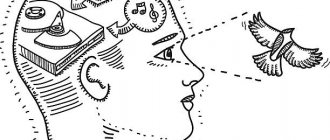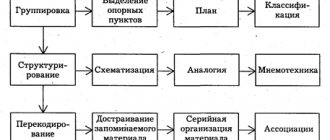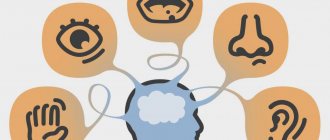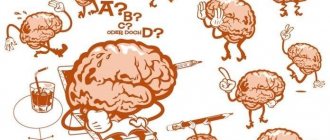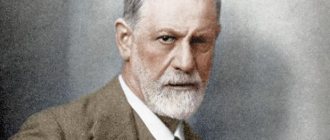Is it possible to erase a person's memory? This cannot be done completely, but it is possible to manage your own negative memories. The girl Anastasia, who had long suffered from obsessive images from the past, managed to learn to control them.
How to erase from your memory memories that prevent you from living peacefully?
“I have always had a lot of situations in my life in which I looked stupid from the outside. It happens that you say something wrong, behave strangely, then you feel ashamed, remember, digest the story. All this settles in the head for a long time, pops up at the most inopportune moment. This kind of obsessive lump spins in my head and gives me no rest.
I often had insomnia. As a result, suffering and physical and moral oppression. I made an appointment with a psychologist because I thought that in my situation this was the only way out. Constant dialogue in my head, unpleasant thoughts and memories did not allow me to calmly go about my business or live a normal life.
The psychologist advised me one exercise for intrusive memories that will help me control them. The idea is to imagine the negative event as if on a movie screen. It is important to make the image large and the format narrow and long.
Then reduce the frame to a small point. Then return the image to its previous size, saturate it with color, and increase the brightness. Next, remove the color completely, make it black and white. The next step is to present the frame in green, blue, and finally orange.
It is necessary to reduce the contrast of the picture so as not to distinguish between the background and the figures. Scroll the frames in the opposite direction, stop. Look at the image at different speeds, from high to slow. Try to hear the sounds.
Make it as loud as possible, then turn it down. Reset the image settings. Slowly turn off the sound, then freeze the picture. Reduce the brightness and intensity, blur the picture. Turn off the image. Leave the screen completely white. Turn it mentally into a white dot, and then into a smoke ring. Your memory has disappeared.
It seemed difficult at first, but over time I brought the exercise to automaticity. As soon as I have unpleasant memories, I get rid of them with this effective method.”
Forgetting as a normal memory process
Have you seen the movie "Eternal Sunshine of the Spotless Mind"? This is a fantastic drama in which lovers erased their memory of a person using a special program. Or rather, this was done by specialists from the company providing this service.
But in life everything happens a little differently. Over time, all vivid emotions and experiences, words spoken and deeds committed are erased from memory on their own, blurred, and begin to seem distant and unimportant.
In this case, erasing from memory is a natural process, but it takes some time. It could be years, even decades. In this case, it is much more difficult to erase a person from memory if he played a large role in your life (lover, lover, loved one).
If a person is no longer in your life, then over time the emotions experienced with him will dull, especially if someone else has replaced him.
Erasing a person’s memory constitutes a specific strategy. You need to allow yourself to forget specific details of an event in order to then get rid of the whole memory.
This means that when a person’s brain tries to remember something intentionally (images, words, events), it creates a certain context. When trying to forget this context, it is rejected, so the person creates memories with difficulty, which then do not last long.
It is more difficult to forget something if the memory is reinforced by triggers. How to erase your memory at home? Try using the flying technique.
Contact a professional: free yourself from negativity with the help of a specialist
Elena Kalachikova is a professional memory development trainer, head of the Shaleniy Ravlik school, a teacher of the highest category with sixteen years of experience. Elena works with children from 5 years old, schoolchildren, students, adults, foreigners and people of retirement age. The trainer claims that he knows everything about memory and can easily teach not only to remember the necessary information, but also to forget negative experiences.
Elena guarantees forgetting negative information using the image of water, rubber band or fire, and also uses the method of repeatedly speaking out an unpleasant situation. We will be glad to see you at the Shaleniy Ravlik school. There is strength in everyone!
Interesting articles
- We train your child's memory and improve his academic performance! Elena Kalachikova participates in the role of an eidetics expert in the program “EVERYTHING WILL BE GOOD.” STB channel.…
- Training memory and attention, “Komsomolskaya Pravda”, June 2014 Publication in the newspaper “Komsomolskaya Pravda”.
- Game "PHOTOGRAPHER" Game "PHOTOGRAPHER" for training visual and photographic memory.
Flying technology: description of the method
How to erase a person's memory? There are techniques that suppress memories, but not completely. They will help if you are wondering how to erase a person from your memory.
The word “flying technology” comes from the root “leta” - this is the river of oblivion in the underworld. Flight methods are used in two cases: to suppress traumatic memories (obsessive), and to erase information that has become unnecessary.
How to erase a particular event from a person’s memory? There are several flying techniques.
- Suppression. It is most often used if intrusive negative memories are tormenting. The more diligently they try to forget and not remember them, the more intrusive they become. To remove the obsessive state, you need to use a special exercise called the “burning letter.” Its essence is that it is necessary to describe this memory on a piece of paper, mentally imagine it in the form of a picture. When memories are described and visualized, a person is freed from them. Afterwards, the sheet with the text must be burned, looking into the fire. It is important to understand that the events of the past crumble, turning into nothing. There is also the “TV” exercise, which helps you stop being afraid of memories.
- Delete. How to erase memories from your memory? Another strategy is to remove information that is no longer relevant. One of the exercises should include the “flying rag”. If some information is present in memory in the form of images, you need to mentally take a large rag and erase what is unnecessary. It is important to vividly imagine that the images are removed, disappear, dissipate and no longer exist.
How to erase a person's memory at home? It's easy to do. Use the techniques presented regularly to develop a habit.
They are quite safe, so it is not difficult to get rid of the negativity in your head. If you are interested in how to erase the memory of a person, then pay attention to the deletion technique. Perhaps you should use the author’s method of forgetting S.V. Shereshevsky.
Special exercises
"Rite"
The essence of the exercise is to get rid of bad memories in the form of a ritual. A person responds well to various psychological anchors created by psychotechnics.
- Option 1. Wash away memories by pouring water on yourself.
It is necessary to imagine a negative experience in the form of dirt or dust adhering to the body. In the process, the water washes away all this dirt, freeing the consciousness. If fantasy is developed well enough, the technique will help you completely get rid of worries about negative experiences. - Option 2. Burn your memories by first writing them down on a piece of paper. It is better to describe the event or situation in as much detail as possible in order to draw the emotions out. Then it will be easier to remove them thanks to the visual sequence of human actions.
- Option 3. You can bury memories if there is something associated with a negative event. In this case, you can arrange an impromptu funeral for this thing, mentally connecting and burying all negative emotions with it.
"Perception"
You need to remember the events as a fragment from a film , i.e. watching him from the side.
Now you can start:
- scroll through the situation in your head, trying on the role of each participant in the event;
- scroll through the situation in your head as if you were looking at what is happening through a TV screen, changing the playback speed from minimum to maximum;
- “color” the picture, observing it in green, red, blue;
- Zoom in and out of people participating in dialogues.
All this will help reduce the significance of the event and the individual people involved in the situation.
Does it make sense to erase events? The value of experience, consequences
Is it possible to completely erase a person's memory? No, you can't do that. But how can you erase unpleasant memories from your memory? This is what most often requires special techniques; some even use hypnosis to forget a particular situation.
The main indications for erasing memory are traumatic situations: crimes, military operations, rape, accidents, disasters. In this case, negative experience is not valuable, since it drives a person into depression and prevents him from living a normal life.
Memory erasing by hypnosis is necessary and is most often performed by a professional. In any case, you can also get rid of negative states on your own, but this is psychological work. The traumatic situation must be accepted and understood.
Try to understand why it happened to you. The job is not easy. Perhaps, if you survived it and remained physically intact, then this is the path to self-knowledge. Even if the situation in the past was terrible, you are alive, so it is important to realize one thing - this is a positive thing.
Understanding the lesson is the step that helps you get rid of negative emotions and stop causing events of the past. If you cannot erase memories from your memory, then contact an experienced psychologist who knows certain techniques, including hypnosis.
It is rare, but it happens that memory erasing is a spontaneous phenomenon. This is a protective reaction of the body, that is, forgetting is a natural mechanism.
In this case, the traumatic information is completely destroyed, including negative emotions. A similar reaction occurs if a person experiences severe fright. However, this does not solve the problem, since a nervous disorder will remain.
How to erase a person's memory? There are artificial methods of forgetting information, including hypnosis, chemical exposure, the creation of false memories, and neurolinguistic programming.
- Hypnosis. This is artificial forgetting, which is suitable for people who have not been able to cope with negative emotions on their own. In this case, memories are not removed from memory, but blocked. Memory erasing through hypnosis is effective, but it is not suitable for everyone. Memories can come back if you remind them.
- Chemical substances. These are pills that weaken neural connections. They help if you need to forget some episode.
- False memories. They are being replaced, and the same thing happens with easily suggestible people.
- NLP. Influences people's memories using psychological techniques (words, gestures, intonations).
It is important to understand that it is possible to erase a person, event or episode from life from memory, but in the end the personality will change.
Such experiments can lead to mental disorders that cannot be cured without the help of doctors. Is memory intervention worth such sacrifices? You decide.
Why is it difficult to get someone out of your head?
Photo by SHVETS production: Pexels
A good analogy is a sailor at sea who has no sailing skills. The wind rocks the sailboat, leaving the sailor completely confused.
Now imagine that a sailor has been taught how to sail. All he has to do is position the sail in the right position to take advantage of the wind and get home easily.
In a sense, you can be “dependent” on a person. In a 2010 study, subjects who had just gone through a breakup but were in love proved how true this idea is.
When they saw photos of their ex, the brain's reward system released dopamine, a neurotransmitter that plays a big role in the early stages of love. A surge in this neurotransmitter can lead to resistance to letting go. You cannot get a person out of your head because thoughts about him are extremely significant to you.
Current research
Drug-induced amnesia
Drug-induced amnesia is the idea of selectively losing or suppressing the creation of memories through the use of drugs. Amnesia may be used to treat patients who have suffered psychological trauma or for medical procedures where anesthesia is not an option. Drug-induced amnesia is also a side effect of other drugs such as alcohol and rohypnol.
There are other drugs that can also cause amnesia in users when they experience a certain type of amnesia due to their use. Examples of these drugs include: Triazolam, Midazolam, and Diazepam.[11]
Disruption of molecular mechanisms
There is a growing body of information showing that memory is largely dependent on the brain's synaptic plasticity, with much of this dependent on its ability to support long-term potentiation (LTP).[12] LTP research has also begun to indicate that there are several molecular mechanisms that may underlie memory storage.[13]
A more recent approach to erasing memories and the associations the brain makes with objects disrupts certain molecular mechanisms in the brain that actively keep memories active.[14]
Methamphetamine recovery (METH) addicts report that the sight of certain objects, such as a lighter, chewing gum, or drug paraphernalia, can trigger intense cravings, which can sometimes impair their mental powers and encourage them to relapse.[2] This indicates that long-term memories can be triggered by various associations that were created with memories without the person's conscious effort. With growing belief that memories are largely supported by functional and structural plasticity derived from the polymerization of F-actin into postsynaptic dendritic spines upon excitation of synapses.[2] Recent studies have been conducted to target this F-actin polymerization using direct actin. depolymerization or myosin Inhibitor II that disrupts polymerized F-actin associated with METH memory associations. Research has shown that types of associations may be disrupted several days or weeks after strengthening.[2] Although depolymerization treatments did not affect food reward-based associations or shock-based associations, the results demonstrate the idea that the actin-associated memory cytoskeleton is constantly changing, making it uniquely sensitive to depolymerization during the maintenance phase. This is one of the first indications that memories associated with different associations are actively maintained using different molecular substrates. These results also suggest that the actin cytoskeleton may be a promising target for selective disruption of unwanted long-term memory.[2]
Selective memory suppression
Selective memory suppression is the idea that someone can consciously block an unwanted memory. Many different therapeutic techniques or training have been conducted to successfully test this idea.[15] Many of these methods focus on blocking the retrieval of memories through various suppression techniques to slowly train the brain to suppress the memory. While some of these techniques have been helpful for some people, they have not shown a clear solution to the problem of forgetting memories. Since these memories are not actually erased but simply suppressed, the question of how permanent the solution is and what actually happens to the memories can be a concern for some.[16]
Selective memory suppression is also something that can occur without the person being aware of the possibility of suppressing the creation and retrieval of unwanted memories. When this happens without the person's knowledge, it is usually called memory suppression; the memory itself is called repressed memory.[17]
Interruption of memory reconsolidation
One way scientists have tried to erase these memories through suppression is to interrupt the recombination of memories. Memory consolidation is when a person recalls a memory, usually a fearful one, it becomes susceptible to change and then is retained again.[18] This has led many researchers to believe that this period is the best time to change or erase memories. Research has shown that behavioral training results have shown that they can erase memories by altering them during the reconsolidation phase.[19]
Neuronal destruction
There is evidence to suggest that different memories excite different neurons or systems of neurons in the brain.[20] Techniques for destroying selected neurons in the brain to erase certain memories are also being explored. Research has begun into the possibility of using various toxins along with biotechnology that allows researchers to see which areas of the brain are used during the reward learning process to create memories to kill target neurons. In a paper published in 2009, the authors showed that neurons in the lateral amygdala that had higher levels of the protein cyclic adenosine monophosphate response element binding (CREB) were activated primarily over other neurons through the expression of fear memory. This indicated to them that these neurons were directly involved in creating the memory trace for this fear memory. They then proceeded to train mice using auditory fear training to evoke a fear memory. They set about testing which neurons overexpressed CREB, and then, using an inducible diphtheria toxin strategy, they destroyed those neurons, resulting in persistent and powerful erasure of fear memory.[1]
Researchers have also found that levels of the neurotransmitter acetylcholine can also influence which memories are most salient in our minds.[21]
Due to the lack of understanding of how the brain works, this method of destroying neurons can have a much greater effect on the patient than simply removing the targeted memories. Because of this complex nature, brain treatments that stun neurons rather than destroy them may be another approach that could be used.[22]
Potential patients
There are several different types of possible patients who could potentially benefit greatly from selective memory erasure; these include people suffering from drug addiction or post-traumatic stress disorder (PTSD). Patients with PTSD may include war veterans, people who have witnessed horrific events, victims of violent crimes, and many other possibly traumatic events. These potential patients have unwanted memories that can be absolutely disruptive to their daily lives and leave them unable to function normally.[7]
Along with patients suffering from these dire circumstances, the idea of selective memory erasing is very attractive to many. make the practical use of this technology something that could be used by many people.[7]
Different types of memories
There are three main types of memories: sensory memory, short-term memory, and long-term memory. In short, sensory memory is the ability to retain sensory information for a short period of time, such as looking at an object and being able to remember what it looked like moments later. Short-term memory is the memory that allows a person to remember a short period of time; this can be from a few seconds to a minute. Short-term memory allows people to remember what happened during that short period of time without actually practicing the memory. Long-term memory has a much larger capacity than the previous two and actually stores information from both of these types of memory to create a long-lasting and large memory. Long-term memory is the biggest target of selective memory erasure research.
Within long-term memory there are also different types of long-term memories. Implicit memory is a type of long-term memory that is usually described as the ability to remember how to use objects or certain body movements (such as using a hammer). Another type of long-term memory, explicit memory, refers to memories that a person can consciously use to remember. Explicit memory can be divided into the following subcategories, one of which is episodic memory, which is the memory of specific events and the information surrounding them, and semantic memory, which is the ability to remember factual information (such as what numbers mean).[8]
Types of memory of greatest concern in memory erasing: emotional memories. These memories often include several different aspects of information that can come from the many different categories of memories mentioned above. These emotional memories are very powerful memories and can have very strong physiological effects on a person.[9] An example of emotional memory can be found in patients suffering from post-traumatic stress disorder; for these patients, the traumatic event has left a lasting emotional memory that can have a profound effect on the person even if they do not consciously recall the memory.[10]
History of the early centuries
Research aimed at gaining a better understanding of what memories are has been ongoing for many years, as has research into memory erasure. Much of the recent history of memory erasure has focused on determining how the brain actively stores and retrieves memories. There have been several cases where researchers have found drugs that, when applied to specific areas of the brain, usually the amygdala, have relative success in erasing certain memories. Back in 2009, researchers were able to track down and destroy neurons involved in maintaining the specific type of memory they were trying to erase. This caused the target memory to be erased.[3]
In addition to the biotechnological approach to studying memory, psychiatric research into how memories work has also been ongoing for several years. Some studies show that behavioral therapy can erase bad memories.[4] While there has been some evidence that psychodynamic therapy and other energy techniques[5] can help forget memories among other psychiatric problems, there is no proven therapeutic approach to trying to erase bad memories.[6]
Nikolai: “She said that she is my wife”
Now Nikolai is 40, he is a happy father of three children. But he still doesn’t remember how he met his wife or how his first child was born. 5 years ago he was in an accident and received a traumatic brain injury. As a result, he lost most of his memories before the accident. concerning his life before the accident.
I woke up in the ward, I remembered my name, who I was, what city I was born in, I remembered my parents. A woman was sitting nearby, crying, saying: “Kolya, you’ve woken up.” And I just didn’t understand who it was at all. Then she told me that she was my wife.
My last vivid memory was fishing with friends, I was about 28 years old. I was definitely not married then and I don’t even recognize my wife by sight. A year after therapy, I remembered fragments of the wedding and my wife. She jumped with happiness that day.
My psychotherapist constantly asks if there was anything painful in my childhood. He even conducted hypnosis sessions, but it’s still not clear. I'm actually taking my loss in stride. To be honest, I don’t even want to restore it all.
Nikolai visits a psychotherapist and a neurologist, who jointly carry out treatment. They believe that such a local memory loss can be rooted in childhood and affect some social contacts.
The following stories are retold by Afisha Daily writers.




